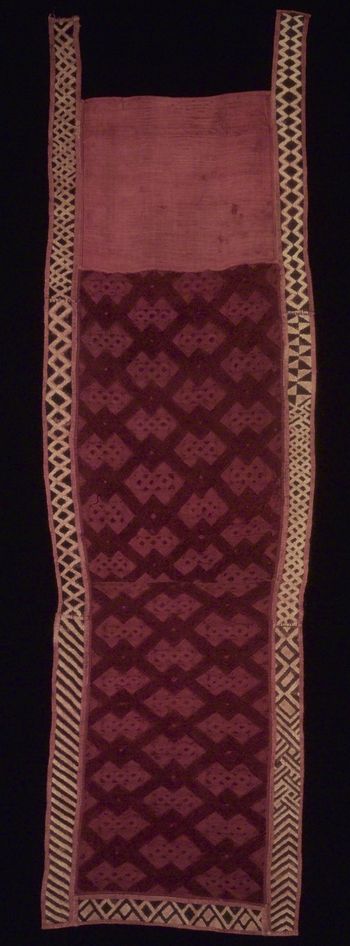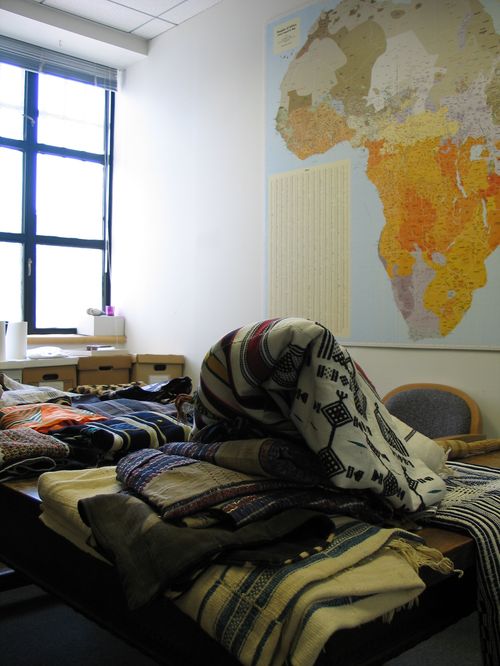Please Touch
Textiles are a crucial element to the story I wanted to tell in African Innovations. Immensely varied in media, form, content and use, textile arts are found in every corner of the continent. They have played important roles in the circulation of wealth, power, ideas and artistic styles, and would remain a central part of the narrative of the gallery focusing on “Arts of the Self.” Brooklyn has a number of standout African textiles from a range of cultures, particularly from the Kuba of central Congo.

Overskirt. Unidentified Kuba artist, late 19th or early 20th century. West Kasai province, Democratic Republic of the Congo. Raffia, pigment. Purchased with funds given by Frieda and Milton F. Rosenthal, 1991. 72
However, textiles also present considerable challenges from the point of view of design and conservation. They tend to require a considerable amount of space (at a premium in this installation), and can only be exposed to light for a limited period of time before needing to be rotated out and returned to storage. For a number of reasons, showing the strengths of Brooklyn’s African textile collection was not in the cards, this time around.
Constraints (to mangle a phrase) can sometimes be the mother of invention, however, and we’ve come up with a new means of presenting the variety of African textile design to our visitors, without sacrificing space or museum objects. African Innovations will instead contain a wall of “touch textiles.” These are mid-to-late 20th century examples of textile genres from around the continent, generously donated by a handful of local collectors, which will be installed in a manner that will permit visitors to feel, as well as see, the variety and ingenuity of African fabric work.
This was a really fun portion of the installation on which to work, as this idea allowed us more flexibility than would be otherwise possible in working with museum objects. I was fortunate to have a wide variety of fabrics from which to select.
We ultimately decided to show 16 different examples of “touch textiles”—ranging from machine-printed kangas from East Africa to bark cloth from the Congolese forests and bogolan (mud cloth) from Mali—in a grid pattern, on one wall of the “Arts of the Self” section. Once I had selected our final 16, Matthew contacted a neighborhood tailor to cut and hem the samples to size.
I hope you’ll have a chance to come and enjoy some (limited) museum rule-breaking and “please, touch!” our textile wall, once African Innovations opens at the end of next week.

Kevin D. Dumouchelle joined the Brooklyn Museum in 2007. He was promoted to Associate Curator for the Arts of Africa and the Pacific Islands in 2012, having served as Assistant Curator since 2008. In 2011 he conceived and curated African Innovations, the Museum’s first chronological and contextual installation of its African collection. He has also curated a number of exhibitions, and contributed to the writing and editing of a major catalogue of works in the African collection, African Art: A Century at the Brooklyn Museum, published by the Brooklyn Museum in association with DelMonico Books • Prestel in fall 2009. Dumouchelle has published on a range of topics, from architecture and canonical African sculpture to contemporary photography, and he has received numerous fellowships and awards. Dumouchelle earned an M.A. and M.Phil. in Art History and Archaeology from Columbia University, where he taught art history and is completing his Ph.D. He has pursued research in Morocco, Mali, and Ghana, and is the recipient of a first-class Master’s degree in history from Oxford University and a B.S. in Foreign Service from Georgetown University.

